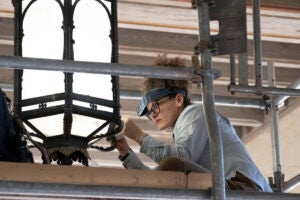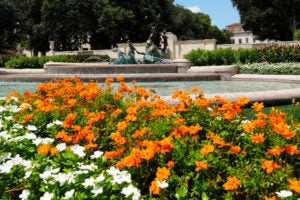AUSTIN, Texas — The Blanton Museum of Art announced today that it will acquire and construct Ellsworth Kelly’s Austin, a 73-by-60-foot stone building to be sited on the grounds of the Blanton at The University of Texas at Austin.
The stand-alone structure, singular to Kelly’s career, comprises a 2,715-square-foot stone building with luminous colored glass windows, a totemic wood sculpture and 14 black-and-white stone panels in marble all designed by the artist. The work will become part of the Blanton’s permanent collection.
“The realization of Austin is a major event in the arts and is a coup for the university,” said UT President Bill Powers. “I’m grateful to everyone who is helping bring this stunning work to the Forty Acres and look forward to it welcoming visitors from around the world.”
Ellsworth Kelly has gifted to the Blanton the design concept for the work, including the building, totem sculpture, interior panels and colored glass windows. The museum has launched a campaign to raise $15 million to realize the project and has received commitments totaling $7 million, including $2 million from Jeanne and Michael Klein; $2 million from Suzanne Deal Booth and David G. Booth; and $3 million from the Blanton family, including $2 million from the Scurlock Foundation and gifts from Leslie and Jack S. Blanton, Jr., Elizabeth and Peter Wareing, and Kelli and Eddy S. Blanton. Beyond the $15 million project budget, Powers has committed $1 million, funded by earnings from the Longhorn Network, to create an endowment for the care and conservation of Austin and for the research and study of Kelly’s work.
“It is a great privilege for the Blanton to share the vision of one of the greatest artists of our time,” said Blanton Director Simone Wicha. “Ellsworth Kelly’s Austin will be a joyful place of inspiration on The University of Texas campus, welcoming millions of visitors from around the world. A treasure in the Blanton’s collection, it will transform the landscape of this vibrant city and have a lasting impact on all who experience it. We are deeply grateful to Ellsworth Kelly and Jack Shear of the Ellsworth Kelly Foundation for their generosity, and to our early supporters, who, with the help of others, will make this important project a reality.”
Ellsworth Kelly is regarded as one of the most important abstract painters, sculptors, draftsman and printmakers working today. After serving in World War II, Kelly moved to Paris in 1948 to study art on the G.I. Bill. The years that he lived in France 1948 to 1954 shaped his art and life in indelible ways. Austin attests to the lasting impact that the simple geometry of Romanesque architecture and the celebrated rose window at Chartres Cathedral, in particular, have had on his art. This building, however, has no religious affiliation, but rather is meant to be a space for contemplation.
It is the only freestanding building Kelly has designed. It features the first works the artist has made in stone and represents the first time he has represented his color spectrum in glass and light.
“Austin is part of a journey that began nearly 70 years ago,” Kelly said. “In Boston in 1947, as an art student at the School of the Museum of Fine Arts, I discovered a 12th-century fresco in the museum’s collection that made a tremendous impression on me. Later, when I was living and working in Paris, I would put my bike on a train and visit early architectural sites all over France. I was intrigued by Romanesque and Byzantine art and architecture. While the simplicity and purity of these forms had a great influence on my art, I conceived this project without a religious program. I hope visitors will experience Austin as a place of calm and light.”
Austin belongs to a distinguished tradition of modernist artist-commissioned buildings, such as the Rothko Chapel in Houston and Henri Matisse’s Chapelle du Rosaire in Southern France. In many ways, Austin brings this celebrated tradition into the 21st century and will undoubtedly serve as one of the high points of the artist’s remarkable 70-year career.
“Austin will allow visitors the opportunity literally to walk into an Ellsworth Kelly: a space of abstraction and light,” said Jack Shear, director of the Ellsworth Kelly Foundation. “This gift will not only enrich the lives of students at The University of Texas at Austin and visitors to the Blanton, but will make the campus a destination for people from around the world.”
The Blanton currently owns a significant early canvas by Ellsworth Kelly, High Yellow (1960), a gift from novelist James A. Michener and his wife, Mari, and an untitled print gifted to the museum by Robert Rauschenberg. In celebration of the Blanton’s commitment to building Kelly’s Austin, David Booth has promised to the museum a recent painting by the artist, Red Relief with White (2007), further deepening the Blanton’s Kelly collection.




